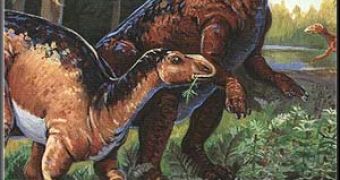As soft tissues are very difficult to fossilize, not to say almost impossible, most of the knowledge we have about ancient life forms comes from fossil bones, teeth and shells.
But paleontologists in Montana have made an important recovery that will help shedding more light on dinosaur life.
An extremely well preserved 67-million-year old duckbilled dinosaur, from the species Edmontosaurus annectens (image), was found with a piece of fossilized skin in the Hell Creek Formation.
To get the precious soft tissue, the researchers used a technique they employed to recover structures resembling blood cells in a Tyrannosaurus rex skeleton in March last year.
The duck billed dinosaurs, one of the most diverse groups of dinosaurs, were plant-eating bipedal (two-legged walking) beasts characterized by a duck-like beak, even if the animals possessed many chewing teeth on the back of their mouth.
"We've only been looking at one thing in the past, the dinosaur skeletal system, but we could learn so much more if we could study their circulatory system and other body systems," said Vince Schneider, curator of paleontology at the North Carolina Museum.
More than 80 % of the skeleton has been recovered, and even more bones might be on the site.
The skeleton misses only an arm, a few toes and a few other bones, being among the top five % most complete dinosaur specimens.
The large piece of fossilized skin once covered the adult dinosaur's back right hip and it is preserved in three dimensions, which is extremely rare.
"The skin appears to have internal structures inside of the scales. These could be some kind of ligament attachments," said Julia Clarke, a North Carolina State University assistant professor of paleontology.
"A CAT scan of the skull, since it's so complete, could reveal the brain cavity, which could then tell us about the shape of its brain. It might then be determined how good the dinosaur's sense of smell and eyesight were," said Richard Kissel, a dinosaur education specialist at the Field Museum in Chicago.
The placement of the skeleton indicates how it died.
"It wound up in fine sandstone stream sediments. It probably drowned crossing at high flow. We haven't found any tooth marks yet suggesting a predator attack," he said.
67 millions ago, during the late Cretaceous period, Hell Creek seems to have been a large tropical river delta that opened into an inland sea, and where dinosaur life bloomed. Fossilized plants also point to the existence of lush forests with hardwood vegetation and leafy plants.
"The food supply must have been ample, since these dinosaurs ate a lot. Our specimen, which would have measured about 24 feet long and was the size of a small elephant, probably weighed between one to two tons," said Schneider.
The arm of the dinosaur was dug without using glue or preservatives in order to decrease the chances of contamination, which could almost make impossible the process of getting the fossilized soft tissue.
The paleontologists believe that such lack of contamination could explain why soft tissue was recovered in the Tyrannosaurus rex.

 14 DAY TRIAL //
14 DAY TRIAL //